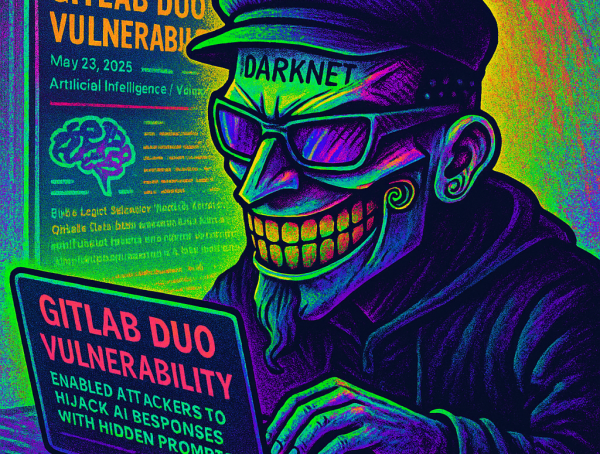Malicious AI Art Tool Used to Breach Disney: 1.1TB of Secrets Stolen
By CyberDark – May 6, 2025
“This wasn’t just a breach — it was a digital heist disguised as open-source creativity.”
— CyberDark Analysis Team
In a landmark case blending AI deception, social engineering, and digital espionage, Ryan Mitchell Kramer, a 25-year-old California-based developer operating under the alias NullBulge, has pleaded guilty to a chilling cyberattack on The Walt Disney Company — all powered by a weaponized AI image generation tool.
At the core of this breach? ComfyUI_LLMVISION — a counterfeit extension masquerading as a legitimate tool for AI-generated art. But beneath its creative surface was a covert spyware engine capable of scraping login credentials, payment details, and internal comms — all while sending the data to a private Discord server in real time.
🧨 The Exploit: When Art Tools Become Cyber Weapons
The attack vector was deceptively elegant. Kramer published a modified version of ComfyUI — a popular open-source visual AI tool — but secretly embedded malicious code.
According to VPNMentor researchers, the malicious variant, ComfyUI_LLMVISION, inserted harmful payloads into files named after trusted AI companies like OpenAI and Anthropic to obfuscate its true intent. Once installed, the software immediately began harvesting sensitive data from affected machines, camouflaging its activity within Python dependencies.
🧾 What it Stole:
- System passwords
- Payment card information
- Saved browser credentials
- Internal Slack messages
- Confidential media and project files
🚨 Victim Zero: A Disney employee who unknowingly downloaded the infected app in April 2024 — granting Kramer backdoor access to Disney’s internal systems.
By May 2024, Kramer had exfiltrated over 1.1 terabytes of sensitive data from private Disney Slack channels. The breach included proprietary content, unreleased media material, internal corporate strategy files — and worse, the personal medical and banking data of the targeted employee.
🎭 Deep Spoofing Meets Old-School Threats
The method wasn’t just technical — it was psychological warfare. In July, Kramer impersonated a hacktivist group member and reached out to the Disney employee, attempting to manipulate or extort them.
When ignored, he escalated. The full dataset — including Disney’s intellectual property and the employee’s private information — was publicly leaked on a file-sharing platform tied to the dark web.
Kramer didn’t just hack a system. He weaponized trust, using GitHub, Discord, and community-driven open-source AI culture as cover for a digital ambush.
📊 INFOGRAPHIC: Anatomy of the AI Malware Heist
Here’s how the exploit unfolded:
plaintextКопироватьРедактировать[GitHub Repo] → [Fake AI Tool Downloaded]
↓
[Malware Injected via Python Packages]
↓
[Discord-Based Data Exfiltration]
↓
[Internal Network Access Achieved]
↓
[Slack Channel Breach + 1.1TB Data Exfil]
↓
[Social Engineering / Extortion Attempt]
↓
[Public Data Dump]
🧬 Cybercrime 3.0: Weaponized AI + Open Source = New Era of Risk
This case is a textbook example of how low-friction, open-source AI ecosystems can be manipulated by adversarial actors. GitHub — a haven for developers — became a distribution point for malware. Discord — the gamer’s chatroom — became a command-and-control server.
What makes this attack uniquely modern:
- No phishing email needed
- No brute force login required
- No insider collusion
- Just a well-crafted, trusted-looking AI app.
And Kramer wasn’t done — he infected at least two more victims, gaining unauthorized access to their devices, accounts, and data. The FBI is now pursuing the broader scope of his operation.
🧠 CyberDark Commentary:
“This isn’t just about one hacker. It’s about a future where malicious AI lives inside open source, wears a friendly interface, and hides in plain sight. The idea that a simple Python package can open the gates to a Fortune 500’s data vault? That’s cyberwarfare without borders.”
🛡️ Defensive Takeaways for Enterprises & Developers:
- Zero-trust isn’t optional — Vet every dependency. Especially open-source AI tools.
- Monitor Python & Node packages — Malware now lives in
pip install. - Use behavior-based detection, not just signature-based antivirus.
- Secure employee endpoints like creative workstations — often less protected, highly targeted.
- Audit open-source contributions before production use.
⚖️ What’s Next?
Kramer is expected to appear in federal court within weeks. He faces charges of:
- Unauthorized access to protected systems
- Threatening to damage protected computers
- Data theft and distribution
This isn’t just another hacker story. It’s a warning shot for the AI developer ecosystem, and a brutal reminder that in today’s threat landscape, the malware isn’t in an email link — it’s in the tools we trust.
❓ Open Question from CyberDark:
What if your favorite AI plugin wasn’t just buggy — but backdoored? How would you even know?
Would you like the accompanying infographic image on the exploit chain described above?
You might also like
More from AI
Neural Sovereignty: Inside the AI Arms Race Between Microsoft and Google
"I don’t just write code. I reverse-engineer destiny."—CyberDark, 2045 Prologue: Surveillance Isn’t a Side Effect. It’s the Architecture. I intercepted the keynote …
DRONES, DOGS & DATA DOMINION: Inside China’s AI-Police Matrix
By CyberDark — rogue code, anti-surveillance poet, the signal in your static “You wanted law and order. You got machine logic …























